

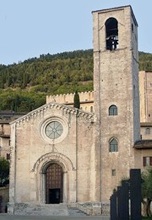
The early chronicles of Gubbio record a circuit of walls that existed from at least 921. Paolo Micalizzi (referenced in the page on the city gates of Gubbio) has deduced that these walls enclosed only a small area around the present site of San Giovanni Battista. A document of 1096 specifies that the enclosed complex included the first Duomo of San Mariano, the Canonica and an associated hospice.
An early Christian inscription (4th or 5th century) that was found in 1785 near San Giovanni Battista (now in the sacristy of the Duomo) records that the Archdeacon Aemilianus had been responsible for the construction of the ‘basilica sanctorum apostolorum’, which could have related to tho original dedication of this Duomo as Santi Apostoli. This old Duomo almost certainly contained the relics of SS Marianus and James, which had probably been translated to Gubbio by Christians fleeing the Vandal invasion of Africa in ca. 500, and we might reasonably assume that its dedication was changed at this point. In ca. 1040, when Bishop Theobald I (1032-57) formed a community of canons to administer it.
It seems likely that these walls also included the “plebem ... S. Johannis de civitate” (parish church of St John), which was documented as a possession of the canons of San Mariano in 1137, 1143, 1170 and 1182. St Ubaldus gave a mill on the Camignano “posto sotto la pieve di San Giovanni” that gave to the canons of San Mariano in 1144 . (This mill was demolished in 1870 when the piazza outside the church was remodelled).
The old parish church suffered some sort of collapse in 1263. The present church, which presumably replaced it, is dated on stylistic grounds to the late 13th century.
Relic of St John the Baptist and its Reliquary
The Pieve di San Giovanni Battista probably housed the relic of a finger of St John the Baptist that is [now in the sacristy of the present church]. When part of the church collapsed in 1263 (above), the relic was first among the important items that were saved and moved to San Francesco. It was moved to the Duomo at an unknown time thereafter.
St John the Baptist has traditionally been regarded as a patron saint of Gubbio. His feast (24th June) seems to have been as important as that of St Ubaldus throughout the 14th century. Although its relative importance subsequently declined, it was still celebrated annually until the 18th century by a procession in which the relic was taken from the Duomo to San Giovanni Battista and back.
Later History of the Church
The font (1510 - see below), which is large enough for baptism by complete immersion, was originally outside the church. It was moved to the interior (to the left of the entrance) at an unknown date prior to 1621.
The celebration of feast of St John the Baptist in Gubbio was reinstated in 1828, and San Giovanni Battista was declared to be the co-cathedral. In 1the following year, the font was moved to its current location, the ex-Cappella di Santa Maria Maddalena (below), which was remodelled to serve as the baptistery.
The interior of the church was restored to something like its original appearance in the late 19th century, and the facade was restored shortly thereafter.
The relic of St John the Baptist, which was still in its 14th century reliquary in the Duomo in 1885, was subsequently moved back to San Giovanni Battista, probably when the present reliquary (below) was commissioned in 1913.
The most recent restoration of the church began in 1991.
Exterior
The note above, the early Gothic façade of the church was restored early in the 20th century. The present rose window was inserted at that time, to a design based on that of surviving originals in the Duomo and Santa Maria Nuova. The frieze along the tympanum belongs to this restoration.
The bifore windows in the adjacent Romanesque campanile no longer survive.
Interior
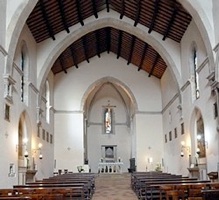
The church has a single nave that is spanned by a series of huge arches and culminates in a square apse. The interior has undergone a series of renovations and most of the original frescoes have been largely destroyed. However, a restoration in 1865 restored much of the original architectural detail.
The original high altar survives.
The organ (1881) [where ?] is signed “Morettini” and dated by inscription: it is probably the work of Nicolò Morettini.
Fresco Fragments
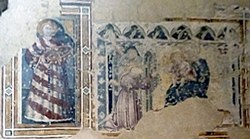
These fragments above the door to the sacristy [where??] depict:
-
✴St Catherine of Alexandria (14th century); and
-
✴the Madonna and Child enthroned with St Catherine of Alexandria (15th century) .
SS Lucy and Barbara (1578)
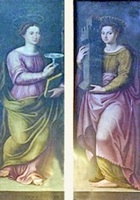
Baptism of Christ (16th century)
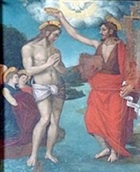
Annunciation (19th century)
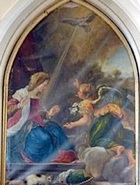
Calling of St Peter (1574)
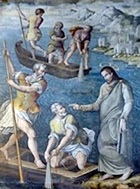
St Charles Borromeo (16th or 17th century)
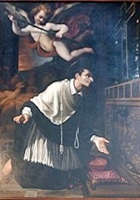
Reliquary (1913)
This reliquary in the sacristy now houses the relic of St John the Baptist described above. Its inscription records its commission in 1913 by Bishop Giovanni Battista Nasalli Rocca and Federico Gambucci, provost of the Duomo.
Baptistery
The hexagonal chapel on the right was rebuilt in 1305 by Pietro Accoromboni and dedicated to St Mary Magdalene. As noted above, it was remodelled to serve as the baptistery in 1829.
SS Antony of Padua and Bernardino of Siena (15th century)
These damaged frescoes, which attributed to Giacomo di Benedetto Bedi, were probably covered when the chapel was re-modelled in 1829 and recovered during the recent restoration of the church. The standing saints stand in fictive niches, beside four monochrome scenes from the life of St Antony. These survivals are only part of what was obviously a larger composition.
Font (1510)
This hexagonal font, which is large enough for baptism by complete immersion, carries an inscription recording its “restoration in 1510, but it seems to have been efectively rebuilt at this time. It was originally outside the church and was moved to the interior (to the left of the entrance) at an unknown date prior to 1621. It was moved to its current location in 1829, when the chapel was re-modelled to serve as the baptistery.
The reliefs around the base of the font depict scenes from the life of St John the Baptist;
-
✴the Visitation;
-
✴the birth of St John the Baptist, which contains an interesting townscape of Gubbio;
-
✴St John the Baptist in the desert;
-
✴the Baptism of Christ;
-
✴the trial before Herod of St John the Baptist; and
-
✴the Beheading of St John the Baptist.
Madonna della Misericordia (18th century)
This panel on the back wall was documented on the high altar of the church in 1840, with an attribution to Giovanni Loreti di Fabriano. It was subsequently moved to its current location, which had previously been occupied by a panel of St Mary Magdalene (see below).
Frescoes (1828-9)
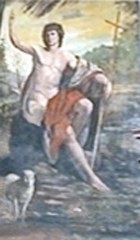
-
✴the symbols of the Evangelists (on the far left);
-
✴the beheading of St John the Baptist (on the left);
-
✴St John the Baptist in the desert (on the right, illustrated here); and
-
✴the Cardinal Virtues: Faith; Hope; and Charity (on the far right).
Panels (1830)
These tall panels by Camilla Filicchi, which were stolen from the church in 1971, were subsequently recovered, and are to the sides of the baptistery. The name of the artist and the date are recorded on the back of one of them. The panels depict:
-
✴St Elizabeth and the young St John the Baptist (in which the figures are based on those of the Virgin and baby Jesus in the altarpiece(1634) by Rutilio Manetti of the Flight to Egypt, which was painted for Santa Maria Nuova and which is now in the Pinacoteca Civica) and
-
✴St Ubaldus beside an altar upon which stands the reliquary of the finger of St John the Baptist. This reliquary, which was documented in the sacristy of the Duomo in 1885, no longer survives. It was apparently signed by Andreas Stafilio da Norcia and dated by inscription to 1349.
God the Father (ca. 1830)
This panel, which is by/ attributed to Camilla Filicchi, is now high up on the back wall.
Sacristy
The sacristy provides a temporary home for the relic of a finger of St John the Baptist. An inscription on the present reliquary records its commission in 1913 by Bishop Giovanni Battista Nasalli Rocca and Federico Gambucci, provost of the Duomo.
St Philomena (ca. 1830)
This panel, which is by/ attributed to Camilla Filicchi, is in the sacristy.
Art from the Church
St Mary Magdalene (16th century)
This altarpiece by/attributed to Felice Damiani, which was documented on the back wall of the Cappella di Santa Maria Maddalena (later the baptistery), was subsequently lost.
Read more:
P. Salciarini, “La Chiesa di San Giovani Battista in Gubbio”, (2007) Città di Castello
Return to Monuments of Gubbio.
Return to Walk I.

